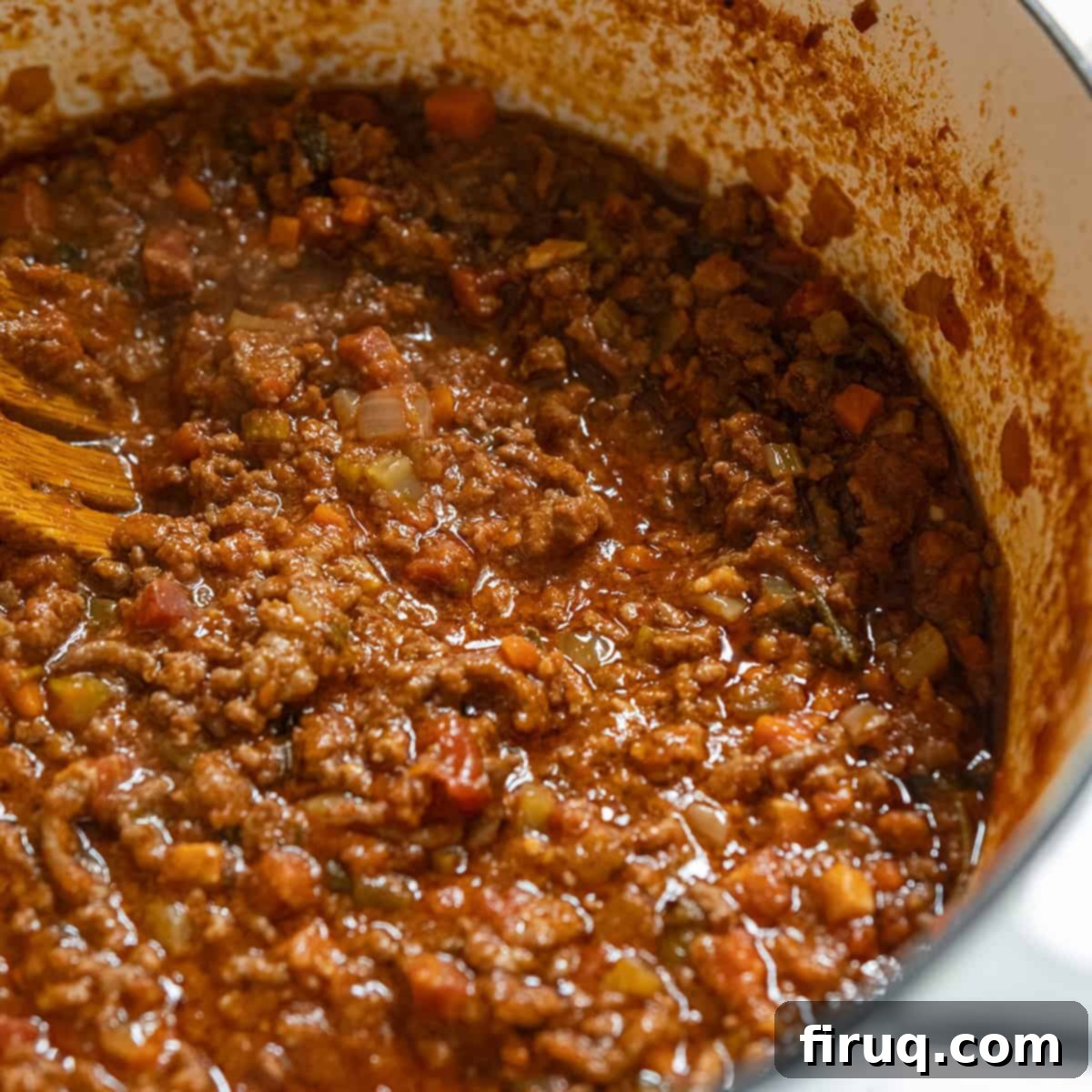Authentic Dutch Oven Bolognese: A Slow-Simmered Italian Masterpiece
Prepare to transform your kitchen into an Italian trattoria with this truly Authentic Dutch Oven Bolognese recipe. This isn’t just a sauce; it’s a labor of love, a rich tapestry of flavors that develops over hours of gentle simmering. As it cooks slowly in your trusted Dutch oven, the aromas of savory meats, aromatic vegetables, robust wine, and sweet tomatoes will fill your home, promising one of the most comforting and complex sauces you’ll ever experience. This Bolognese is the ultimate Italian meal, especially on a chilly day, perfectly served over wide pappardelle pasta with plenty of crusty Italian bread to savor every last drop of its magnificent flavor.
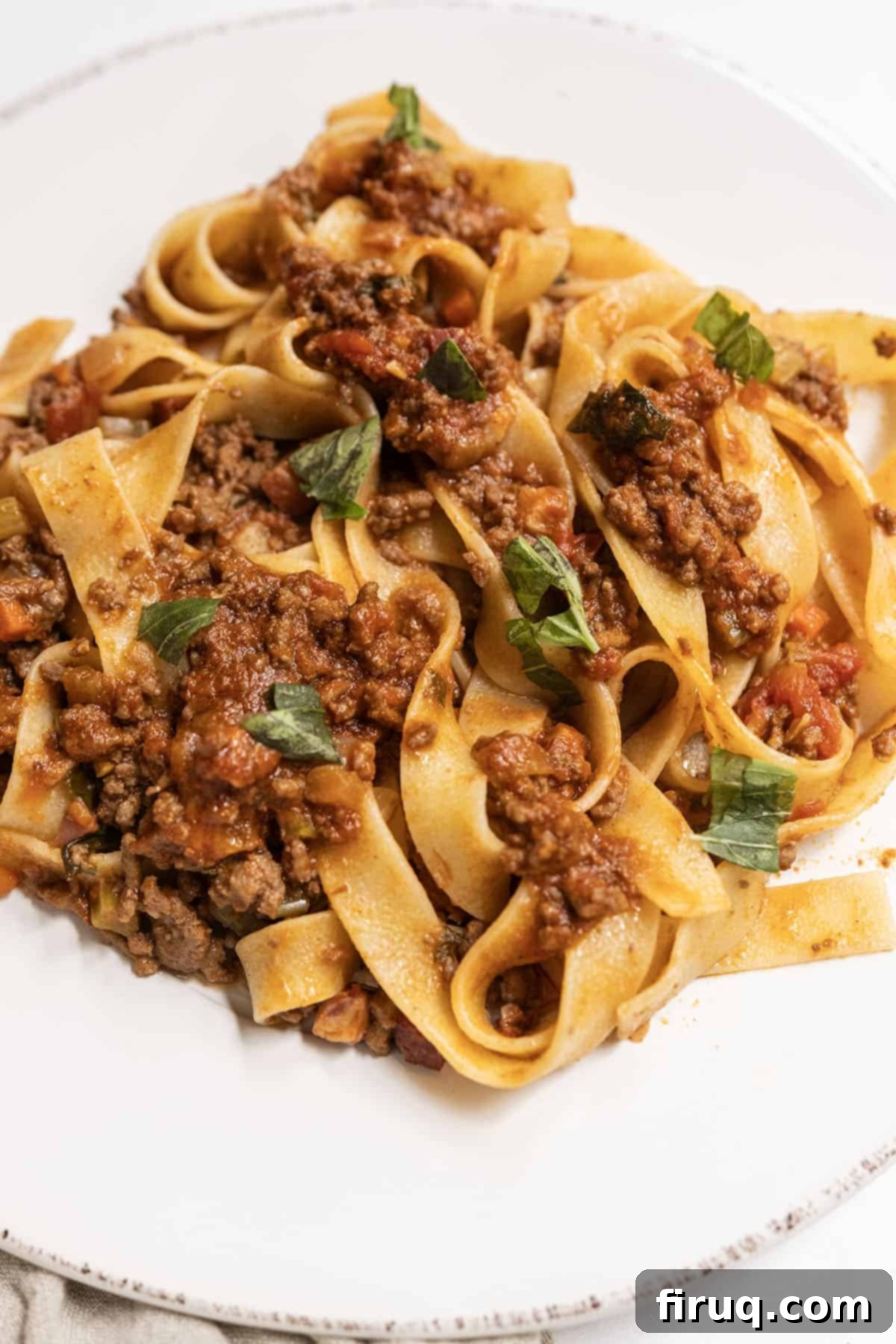
Craving a delicious pasta sauce but short on time? Explore our Quick Lamb Ragu or Creamy Red Pepper Sauce for faster options.
The Magic of Dutch Oven Bolognese: A Deep Dive into Slow Cooking
This Authentic Bolognese stands apart as an unbelievably deep and complex sauce, a true culinary marvel that rewards patience and time. It embodies an all-day braising event, leaving your home permeated with the most incredible aromas of sweet tomatoes, savory onions, pungent garlic, and rich red wine. Bolognese is a dish for those who appreciate the journey as much as the destination—it’s for people eager to dedicate a leisurely Sunday to the art of cooking. There are no shortcuts or “secret cheat codes” to accelerate its development; its depth of flavor comes solely from unhurried simmering. Making it in a Dutch oven is, without a doubt, the superior method to ensure it cooks evenly, preventing any scorching and allowing the flavors to meld perfectly over several hours.
For me, this is more than just a recipe; it’s one of my most cherished culinary endeavors. I find immense joy in the process, in spending the time to craft such an exquisite delicacy for my family. It’s a dish I often choose to prepare for guests, knowing its rich flavors and comforting presence will always impress. I love serving it alongside a crisp Caesar salad, complete with Traditional Caesar Dressing and homemade, crunchy Italian Parmesan Croutons, for a perfectly balanced Italian feast.
If you’re looking to elevate your cooking skills and immerse yourself in the kitchen, this Bolognese offers a fantastic opportunity to master the technique of braising meat. The essence of putting “love into a dish” isn’t about magical ingredients; it’s about patience and dedication. It’s about taking the necessary time at every step to ensure something truly perfect for your loved ones. This slow-cooking philosophy is universal: many cultures boast signature recipes that demand hours of simmering or braising. From Italian Bolognese and ragu to Mexican and Caribbean delights like Dutch Oven Barbacoa Tacos, the principle remains the same: good things take time.
Ingredient Notes and Thoughtful Substitutions
Crafting an exceptional Bolognese begins with understanding the role each ingredient plays. While the recipe aims for authenticity, knowing the purpose behind each component can help you make informed decisions or substitutions if needed.
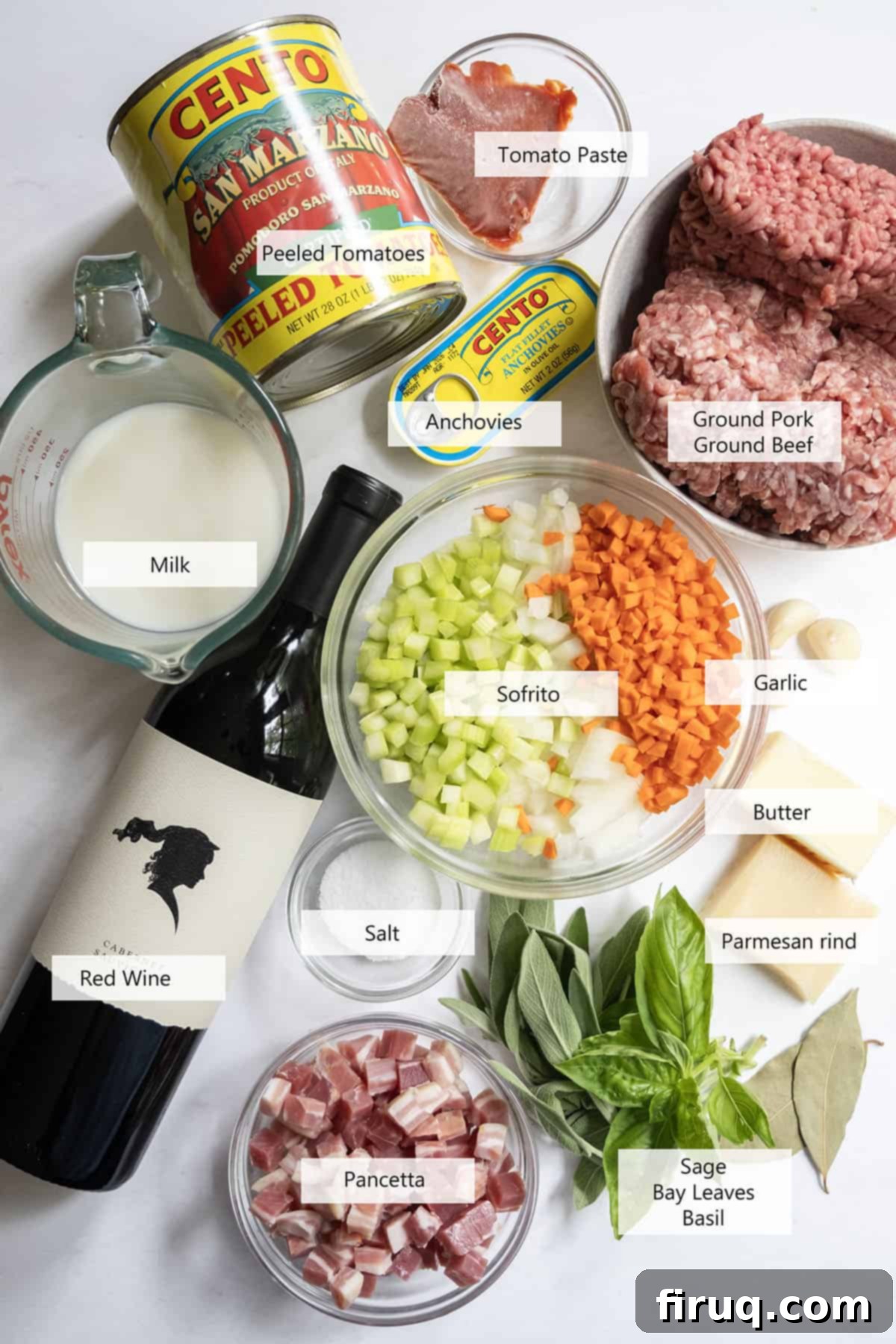
- Pancetta: This cured Italian pork belly is crucial for the foundational flavor. Its subtle, slightly peppery taste and fat render beautifully, creating a rich base for the sofrito. Bacon is *not* an acceptable substitute here due to its smoky flavor which will overpower the delicate balance of Bolognese. While guanciale (cured pork jowl) could work, pancetta’s milder profile is ideal. If you’re keen to use guanciale, try it in classics like Bucatini Amatriciana or Pasta Alla Gricia.
- Sage: Fresh sage is a non-negotiable signature flavor of an authentic Bolognese. Its earthy, slightly peppery notes are infused throughout the sauce as it simmers. Dried sage lacks the vibrancy and smoothness of fresh leaves, so for the best results, stick with fresh.
- Red Wine: A dry red wine with good tannins, such as a Cabernet Sauvignon or Syrah, is recommended. The tannins in the wine play a vital role in breaking down the fats in the meat, contributing to the sauce’s rich and complex character, and adding a layer of depth that simply cannot be skipped.
- Whole Plum Tomatoes: For this recipe, I advocate for using whole plum (San Marzano-style) tomatoes and crushing them by hand. This allows them to break down naturally and slowly over the long simmer, integrating seamlessly into the meat sauce. Crushed tomatoes can be substituted for convenience, but the hand-crushed method offers a superior texture and flavor development.
- Meat: A combination of ground beef (preferably 85% lean) and ground pork provides the ideal texture and flavor profile. I intentionally avoid using Italian sausage, as its specific seasoning (fennel, anise, etc.) can distract from the nuanced flavors of a traditional Bolognese. The goal is a rich meat sauce where the combined flavors of the beef, pork, sofrito, and other aromatics shine through.
- Milk: Use whole milk only. This might seem unusual, but milk is key to tenderizing the meat. When added early in the cooking process, it helps soften the meat fibers, ensuring a wonderfully tender texture that never feels chewy, even after hours of simmering.
- Anchovies: Don’t be deterred by the thought of anchovies! While optional, they are a secret weapon for adding an incredible layer of savory depth, or “umami,” without imparting any fishy taste to the final dish. They dissolve completely, leaving behind a profound richness that elevates the Bolognese to another level. You won’t know they’re there, but you’ll definitely taste the difference.
*For detailed quantities and a complete list of ingredients, please refer to the recipe card below.
Crafting Authentic Bolognese: A Step-by-Step Guide
The KEY to an exceptional Bolognese lies in time and patience. Resist the urge to rush any part of this process; embrace the slow simmer that allows the flavors to deepen and meld. While the initial steps require active cooking, much of the magic happens during the long simmering phase, where your main task is simply to stir every half hour or so. Let’s embark on this culinary journey.
Building the Foundation: The Pancetta and Sofrito
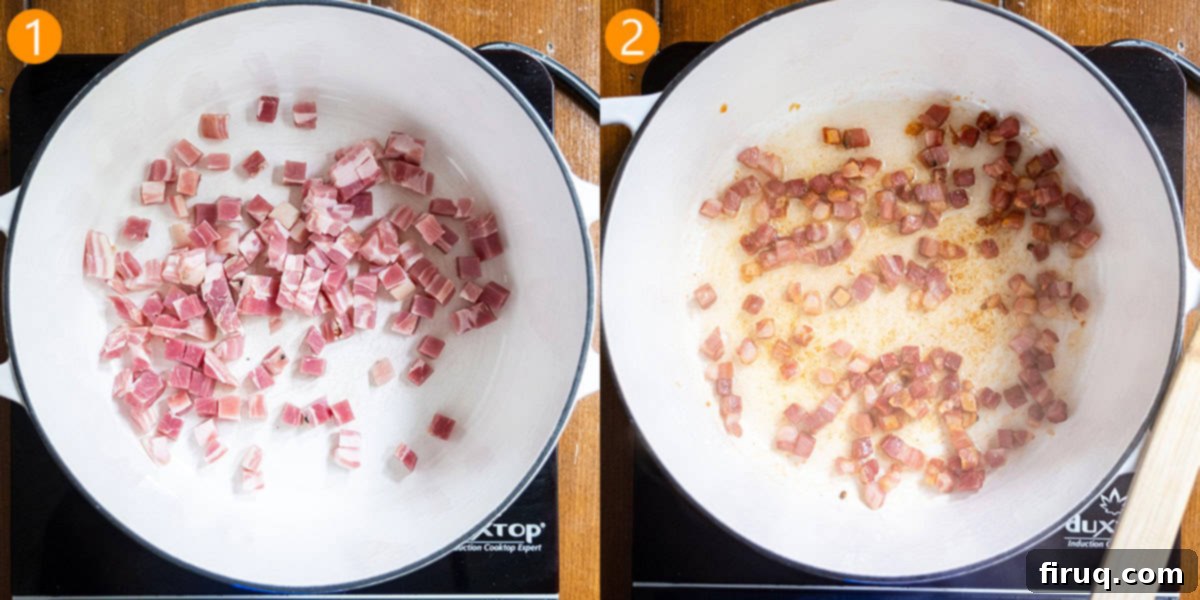
The process begins by rendering the pancetta slowly to extract its flavorful fat, which will then be used to gently sauté the sofrito—the aromatic base of carrots, celery, and onions.
Step 1: Place a ¼ pound of finely chopped pancetta into a cold Dutch oven. This gradual heating allows the fat to render slowly and evenly. Turn the heat to medium and stir the pancetta frequently until its fat becomes beautifully translucent. This step is crucial for developing depth.
Step 2: Continue frying for approximately 8 minutes in total, allowing the pancetta to develop a subtle golden hue and crispness. The rendered fat is liquid gold for your sauce.
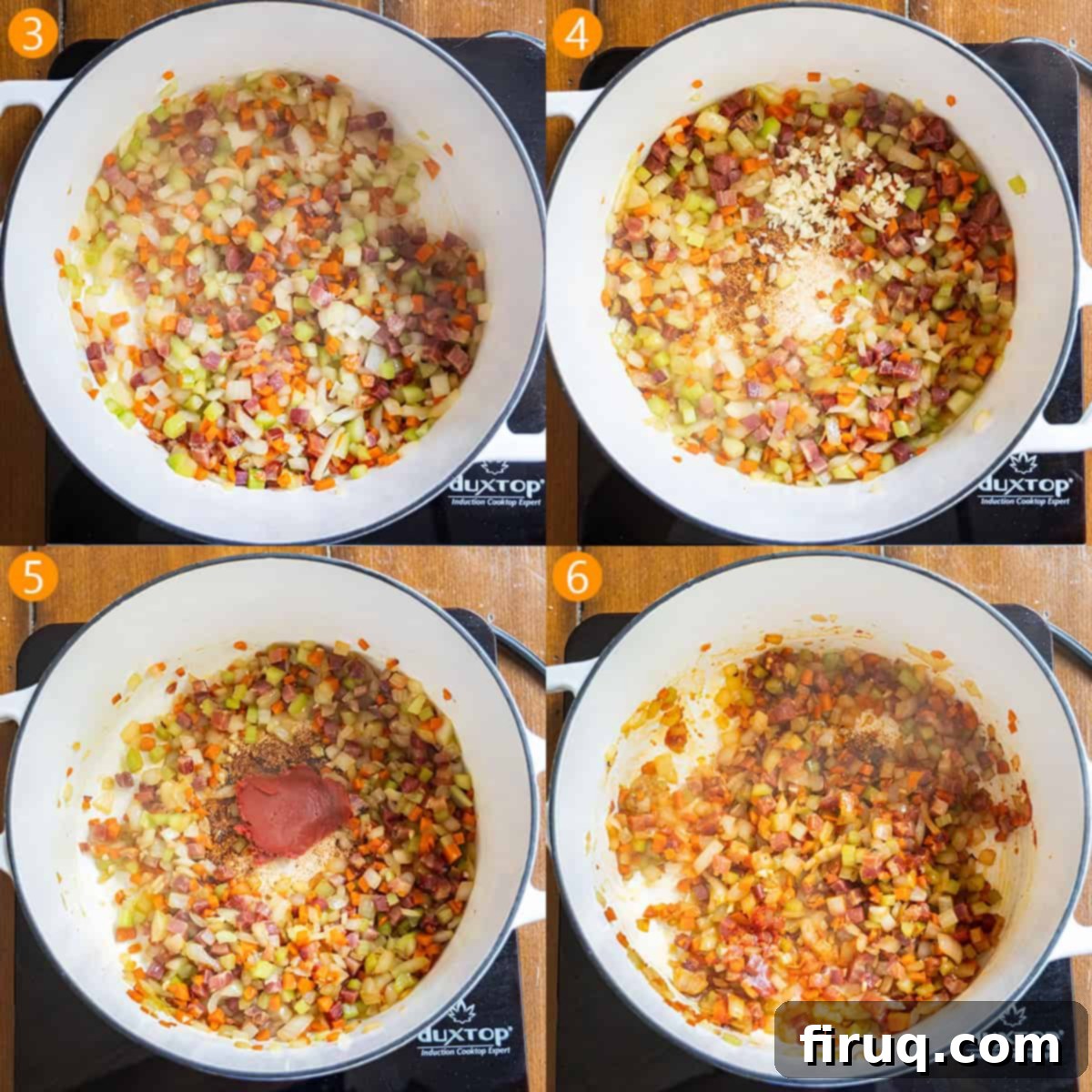
With the pancetta rendered, it’s time to build the aromatic foundation of the sauce—the sofrito.
Step 3: Add the finely chopped carrots, celery, and onions to the pot, stirring them into the rendered pancetta fat. Sauté for 8-10 minutes until the vegetables become delightfully softened, but be careful not to brown them, as we want their sweet, gentle flavors. Season with a pinch of salt and pepper during this cooking stage to enhance their natural taste.
Step 4: Once the onions are translucent and the vegetables are tender, stir in 3 cloves of minced garlic. Cook for just 2 minutes until fragrant, being careful not to burn the garlic.
Step 5: Push the vegetables to the sides, creating a well in the bottom of the pot. Place 2 tablespoons of tomato paste directly onto the hot surface of the well. Allow it to caramelize for 2 minutes; this deepens its flavor significantly.
Step 6: Finally, stir the caramelized tomato paste through the entire vegetable mixture and cook for an additional 2 minutes, ensuring all components are well combined and infused with the rich tomato flavor.
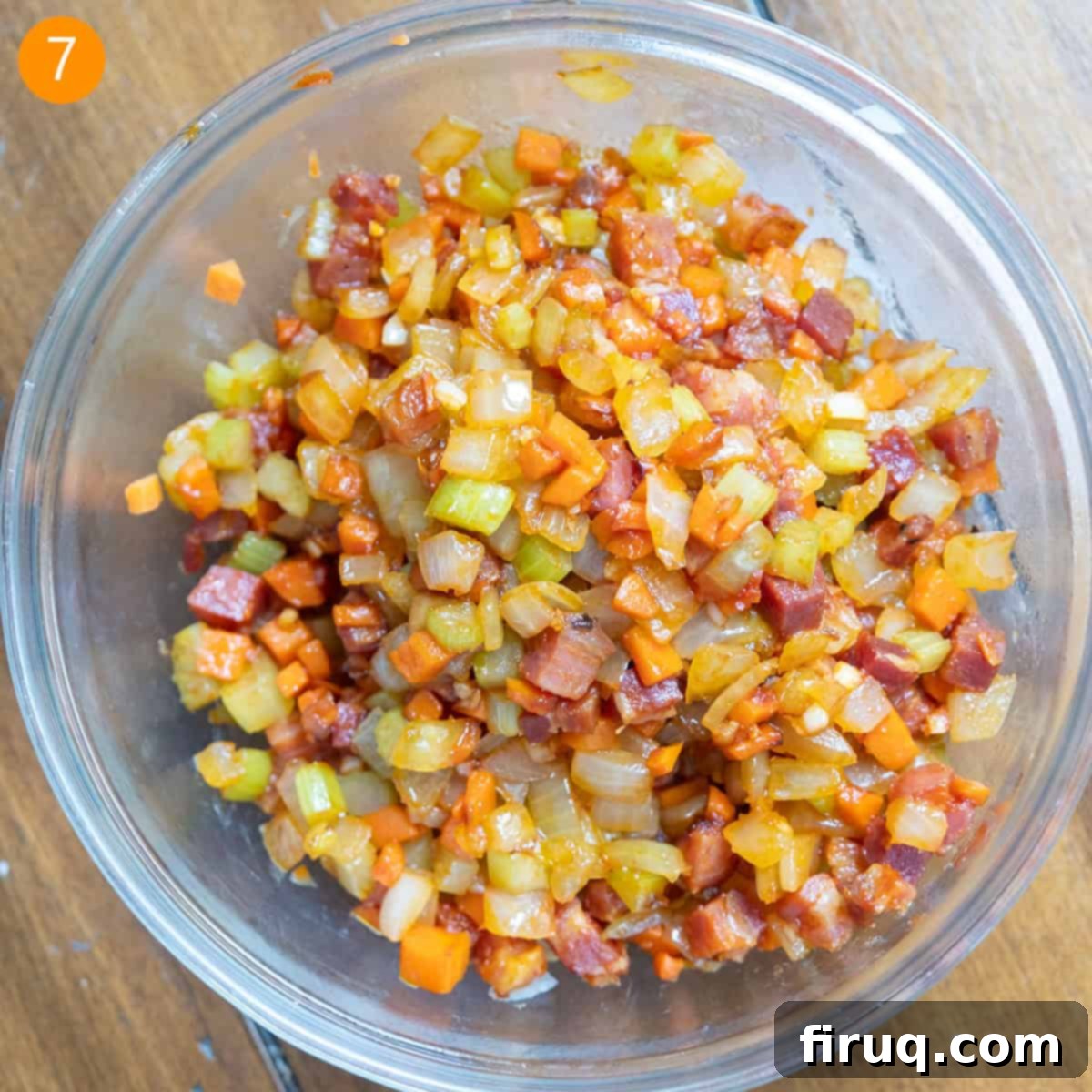
Step 7: Carefully remove the fragrant vegetable mix from the Dutch oven and transfer it to a separate bowl. Set aside; this rich sofrito will be reunited with the meat later to build the sauce’s complex layers.
Tenderizing the Meat: A Crucial Step
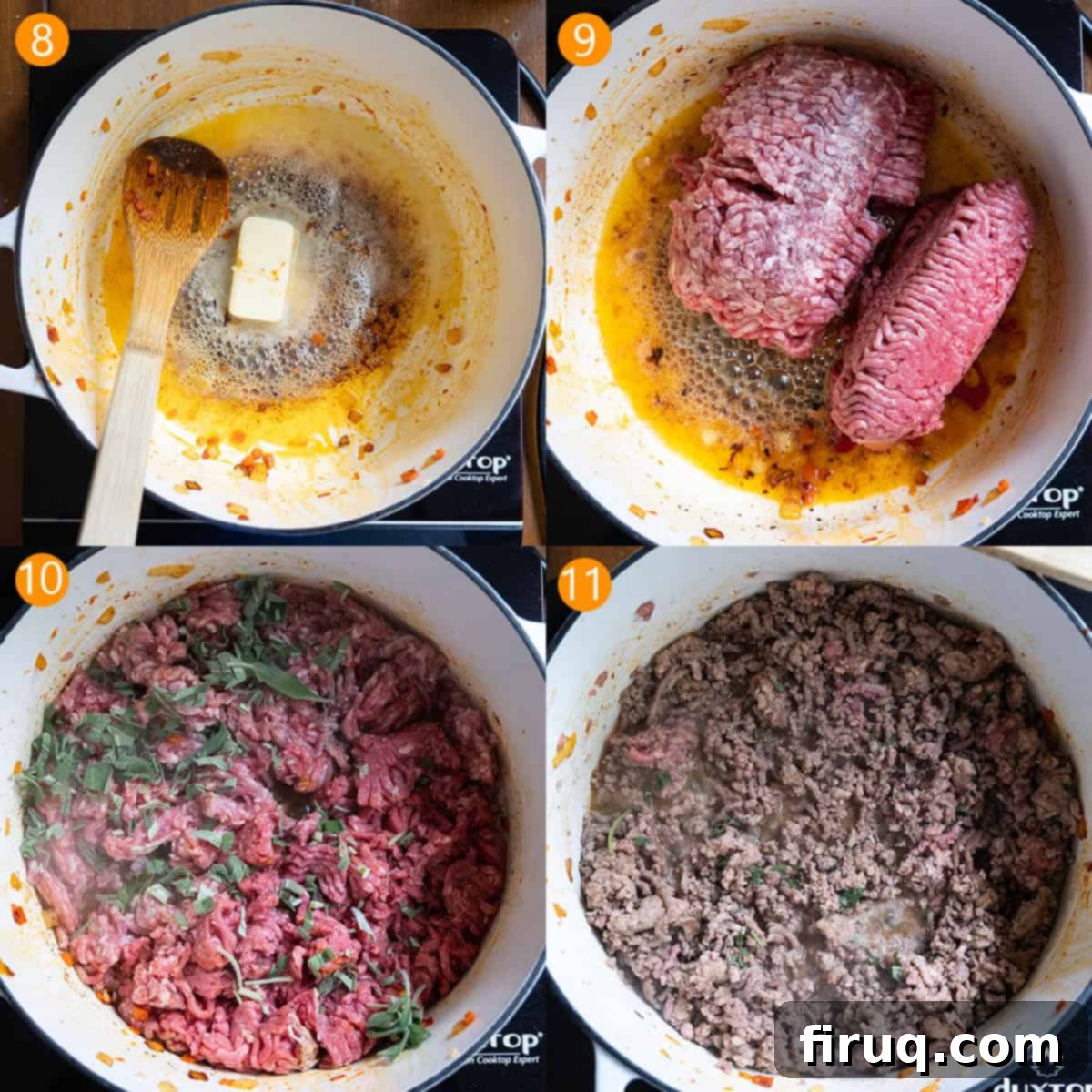
Unlike many meat sauces, Bolognese aims for incredibly tender, not seared, meat. Butter is used for its gentle browning properties, and milk is introduced early to begin the tenderization process, resulting in a velvety texture.
Step 8: Return the Dutch oven to medium heat. Add 4 tablespoons of butter and allow it to melt completely, waiting until the foaming subsides. This signals the butter is ready for the meat.
Step 9: Carefully add the ground beef and ground pork to the melted butter. Immediately begin to break the meat apart with a wooden spoon, ensuring no large clumps form. This is crucial for a smooth sauce.
Step 10: Stir in a generous pinch of salt and the fresh sage. Remember, fresh sage is essential for that signature bright, earthy flavor, so avoid dried sage here.
Step 11: Continue to cook and break apart the meat until it is no longer pink, typically 6-10 minutes. The goal is to cook it through without searing or crisping it. Next, add the finely chopped anchovies and stir for another 2 minutes; they will dissolve and add incredible depth. Finally, pour in the milk and let it gently simmer for 10 minutes, allowing the meat to absorb its tenderizing properties.
The Long Simmer: Developing Unforgettable Flavors
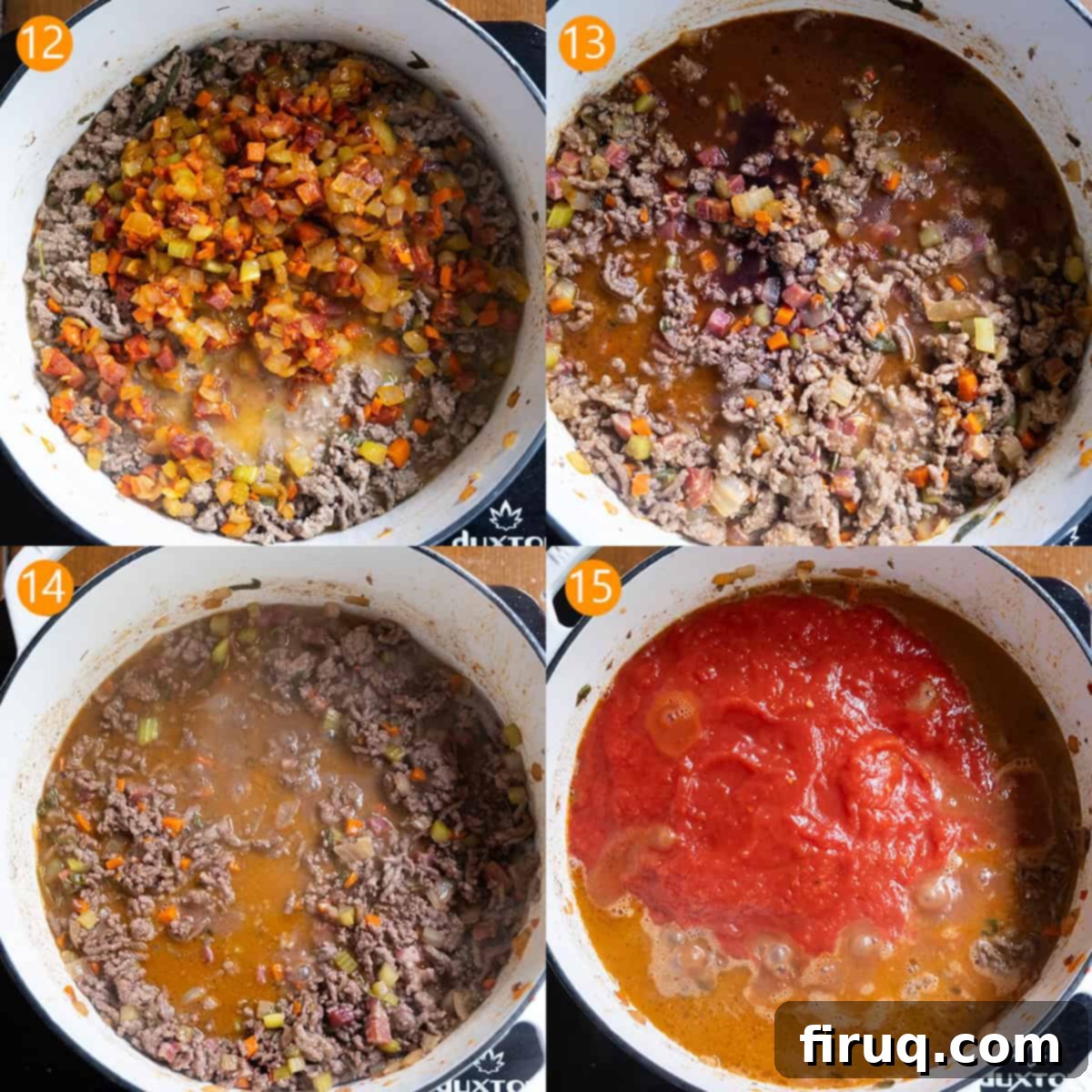
Now, all the carefully prepared components come together to begin the slow transformation into a truly remarkable Bolognese sauce.
Step 12: Once most of the milk has been absorbed by the meat, return your reserved vegetable and pancetta mix to the Dutch oven. Stir thoroughly to combine all the delicious elements.
Step 13: Pour in the red wine. Using a wooden spoon, scrape the bottom of the pan to release any flavorful browned bits (fond) that have accumulated. This deglazing step adds an immense amount of savory depth to the sauce.
Step 14: Allow the red wine to simmer for about 10 minutes, stirring occasionally. This reduces the wine, concentrating its rich flavors and cooking off the alcohol.
Step 15: Stir in the hand-crushed whole tomatoes (or crushed tomatoes if using). Bring the entire mixture to a gentle simmer.
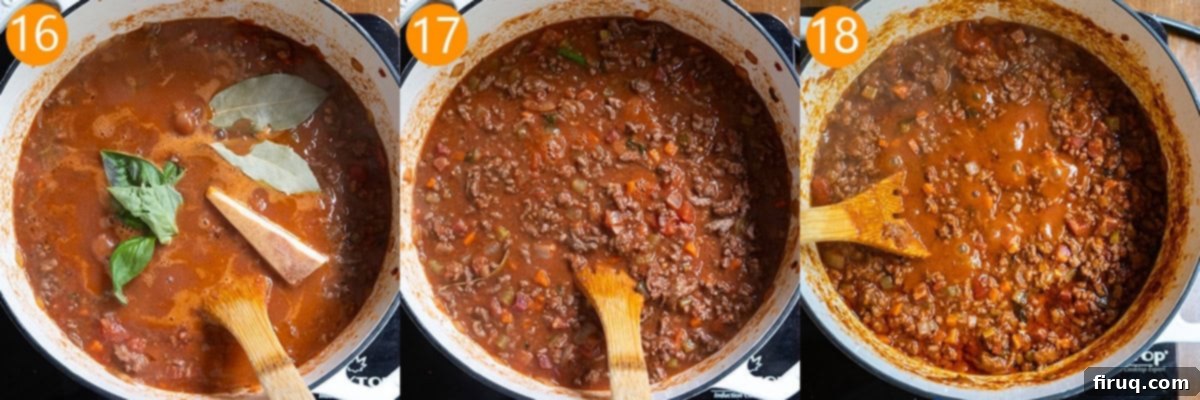
This is where the magic truly unfolds. The low, slow simmer allows all the distinct flavors to marry and deepen, creating an incredibly rich and satisfying sauce.
Step 16: Add the fresh basil, bay leaves, and the optional (but highly recommended) parmesan rind to the sauce and give it a good stir. The rind will slowly melt and impart a fantastic savory depth. Remember to remove the rind and bay leaves before serving!
Step 17: Reduce the heat to medium-low, cover the pot with the lid slightly ajar to allow some steam to escape, and let the sauce gently simmer for a generous 4-5 hours. This extended cooking time is non-negotiable for authentic flavor development. Stir every 30 minutes or so to prevent sticking and ensure even cooking.
Step 18: By the end of the simmering period, the sauce should have significantly reduced and thickened, becoming a rich, concentrated mixture primarily of tender meat with just a small amount of luscious sauce binding it together. Always remember, authentic Bolognese is fundamentally a meat sauce, not a tomato sauce with meat. The heavy bottom of a Dutch oven is indispensable for this process, allowing the sauce to thicken and develop over many hours without the risk of burning. Just like other remarkable slow-cooked sauces such as Bison Ragu or Authentic Italian Sunday Sauce, true depth and complexity require dedicated time.
Once your rich, aromatic Bolognese is ready, serve it generously over a flat, wide pasta like pappardelle, which is perfect for clinging to the substantial sauce. Garnish with a sprinkle of fresh basil and plenty of grated Parmesan cheese. If you’re feeling particularly indulgent, a dollop of creamy ricotta on top adds a luxurious touch. This versatile sauce also pairs wonderfully over a Classic Creamy Polenta for an equally delicious and hearty meal.
Pro-Tips for Your Best Bolognese Ever
Mastering Bolognese is all about understanding a few key principles. These professional tips will help you achieve the rich, complex flavors and tender texture that define truly authentic Bolognese.
- Typically, using a red wine high in tannins will yield the best results for Bolognese. Tannins are organic compounds that create a drying, astringent sensation in your mouth and are excellent at breaking down the richness of meat and fat. This interaction helps to develop a sauce with a richer, more intense, and beautifully balanced flavor profile.
- Consider your wine pairings for steak: a robust red wine like a Cabernet Sauvignon or Syrah is often recommended because its high tannins effectively cut through the fat of the steak. This same principle applies to Bolognese; I always opt for a Cabernet to achieve that perfect balance.
- After incorporating the milk, cultivate patience. Allow it to slowly absorb into the meat and gently simmer away. The milk’s mild acidity and calcium interact with the meat’s connective tissues, effectively softening and tenderizing it. This crucial step ensures that your meat sauce never feels chewy, resulting in an incredibly luscious and smooth texture.
- An authentic Bolognese demands to simmer over hours, not minutes. This extended cooking time, ideally 4-5 hours in a Dutch oven or a heavy-bottomed pan, is what allows the myriad flavors to meld, deepen, and concentrate into the rich, complex sauce you’re aiming for. Rushing this process will compromise the final taste and texture.
- Do not sear the meat. This is a critical distinction for Bolognese. Unlike many other meat sauces where searing is desired for a crust, here we want the meat to remain incredibly soft. This is why we cook it in butter rather than olive oil, and it’s important to break apart the meat and move it often. You’re looking for cooked, tender meat, not crispy beef or pork, to achieve the velvety mouthfeel characteristic of Bolognese.
- Bolognese is an excellent make-ahead dish. Its flavors deepen and improve overnight, making it even more delicious the next day. Prepare it a day in advance and store it in the refrigerator; gently reheat before serving.
Perfect Pairings: What to Serve with Bolognese
Authentic Bolognese is a hearty and rich meat sauce, so when planning your meal, it’s a good idea to balance it with lighter appetizers and fresh vegetable side dishes. Here are some ideal companions for your Italian feast:
- Begin your meal with some delightful appetizers that won’t overwhelm the palate. Consider serving Easy Italian Stuffed Artichokes for a savory start or a refreshing Eggplant Caponata, which offers a bright, tangy contrast.
- For vegetable side dishes, keep it simple and fresh. Garlic Parmesan Green Beans offer a crisp, savory element, while a sautéed Italian Lacinato Kale provides a slightly bitter counterpoint that cleanses the palate beautifully.
- And no matter how satisfying the Bolognese is, always leave room for dessert! Finish your memorable Italian night with a festive Rainbow Cookie Cake or an elegant Pistachio Cream Tiramisu for a sweet, decadent conclusion.
Recipe FAQs: Your Bolognese Questions Answered
Milk is added to Bolognese primarily to help soften and tenderize the meat. As the meat simmers in the milk, the mild acidity and calcium present in the milk react with the meat’s proteins and connective tissues, breaking them down gently. This process ensures the ground meat achieves an incredibly tender, almost velvety texture, preventing it from becoming tough or chewy after hours of cooking, which is crucial for authentic Bolognese.
Anchovies are a classic, albeit sometimes surprising, addition to many complex Italian sauces, including Bolognese. Their purpose is not to make the sauce taste fishy, but rather to provide a profound boost of savory “umami” flavor. Anchovies dissolve completely into the sauce during cooking, enhancing its overall depth and richness without being individually detectable. They add another layer of complexity that elevates the Bolognese from merely good to truly spectacular.
Traditional Bolognese, or Ragù alla Bolognese, is a slow-cooked Italian meat sauce originating from Bologna. It is primarily made from a combination of ground meats (typically beef and pork, sometimes with a small amount of veal), a soffritto (a finely diced aromatic base of carrots, celery, and onion), and often includes pancetta, milk, dry red wine, and a small amount of tomato. Unlike many other pasta sauces, it is characterized by its rich, thick, meat-forward consistency and its long, gentle simmering process, which develops profound flavors rather than being a quick tomato-heavy sauce.
More Amazing Pasta Sauces to Explore
- Bison Ragu
- Italian Short Ribs with Gnocchi
- Authentic Italian Sunday Sauce
- Italian Pink Sauce with Sausage
We love hearing from you! Please leave a comment or review below to share your thoughts and experiences with this recipe. For more culinary inspiration and instructional videos, be sure to follow us on Instagram @vindelgiudice!
📖 Recipe
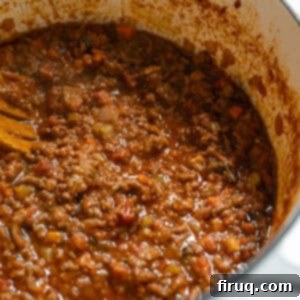
Authentic Bolognese (Dutch Oven)
Vincent DelGiudiceEquipment
-
1 dutch oven
Ingredients
- 1 lb ground beef, 85%
- 1 lb ground pork
- 2 carrots, chopped
- 2 celery stalks, chopped
- ½ onion, chopped
- 5 cloves garlic, minced
- 2 tablespoon tomato paste
- 1 28 oz can whole plum tomatoes
- ½ cup sage, chopped
- ½ cup basil chopped
- 2 bay leaves
- 2-3 tsp salt
- 1 cup milk
- 1 cup red wine
- 2 tablespoon butter
- 4 anchovy filets, chopped
- 2 tablespoon olive oil
- ¼ lb pancetta, chopped
- 1.5 lbs pappardelle
- 1 parmesan rind optional
Instructions
-
In a dutch oven, bring olive oil to medium-high heat. Add pancetta and saute for 6-8 minutes until the fat is translucent and the meat starts to turn golden brown. Stir in chopped onions, celery, and carrots and saute for another 8 minutes until vegetables soften, but not brown. Add ½ teaspoon of salt while cooking. Add minced garlic and stir for another minute. Create a well for a tomato paste and add directly onto the pan. Let tomato paste sit for 2 minutes then stir throughout the mixture. Remove from the heat and place the mix in a bowl.
-
In the same pot, add butter and wait until the foaming subsides. Add in pork, ground beef, 1 teaspoon salt, and chopped sage. Do not sear the meat. Stir often to avoid searing and cook for about 8-10 minutes until meat is no longer pink. Stir in chopped anchovy and cook for another 2 minutes.
-
Pour milk into the meat mixture and cook for about 6-10 minutes until most of the milk becomes absorbed. Add the vegetables back in and then add red wine, and allow it to simmer for about 10-15 minutes until mostly absorbed.
-
Hand crush the whole tomatoes and pour them into the meat. Add 2 bay leaves, half of the basil, parmesan rind and ½ teaspoon salt. Stir and bring to a simmer. Cover the pot leaving an opening and low simmer for 4-5 hours. Bolognese should not be saucy, when it is finished when it is a very thick meat sauce. Stir occasionally throughout simmering.
-
Serve over pappardelle with extra parmesan and basil.
Notes
- Typically, using a red wine high in tannins will be best for bolognese. Tannins will help break down the meat flavor and develop the sauce into a richer and more intense flavor.
- Think about when you order a steak. A red wine, like cabernet or syrah, would go great with that because the tannins help cut through the fat in the steak. I use a cabernet for bolognese.
- Be patient after you pour the milk in. Let it slowly absorb into the meat and simmer away. The milk will soften the meat so that the meat sauce never feels chewy.
- An authentic bolognese needs to simmer over hours not minutes. Let this meat sauce develop over 4-5 hours in a dutch oven or heavy-bottomed pan for the best results.
- Do not sear the meat. That’s why we place it in butter not oil. Break apart the meat and move it often. We’re not looking for crispy beef or pork, you want the meat to be soft.
- Bolognese can be prepared a day ahead and stored in the refrigerator.
